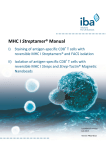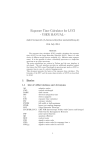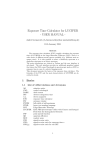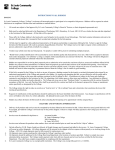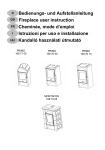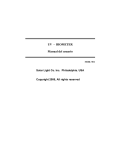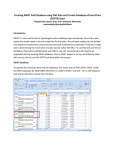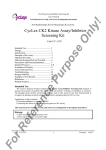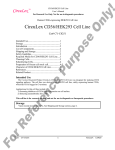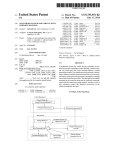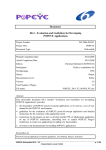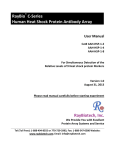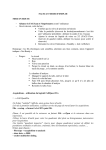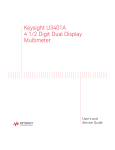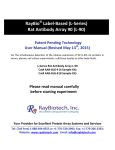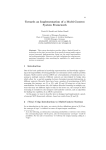Download PR22 MHC Streptamer Manual_0005_2012 Version 2
Transcript
Streptamer® Manual Antigen-specific staining and functional isolation of T-cells Last date of revision April 2012 Version PR22-0005 www.streptamer.com For research use only Important licensing information Strep-tag® technology for protein purification and detection is covered by US patent 5,506,121, DE patent 42 37 113, JP patent 3865792, UK patent 2272698 and French patent 93 13 066; the tetracycline promoter based expression system is covered by US patent 5,849,576 and EU patent 759 997 and Strep-Tactin® is covered by US patent 6,103,493 and EU patent 835 934. Streptamer technology is covered by US Patent 7,776,562 and JP Patent 4 416 400. Further patent applications are pending world-wide. Purchase of reagents related to these technologies from IBA provides a license for non-profit and in-house research use only. Expression or purification or other applications of above mentioned technologies for commercial use require a separate license from IBA. A license may be granted by IBA on a case-by-case basis, and is entirely at IBA's discretion. Please contact IBA for further information on licenses for commercial use. Trademark information Strep-tag®, Strep-Tactin® and Streptamer® are registered trademarks of IBA GmbH. Other trademarks and disclaimers MACS ® is a registered trademark of Miltenyi Biotec GmbH Ficoll-Paque™ is a registered trademark of GE Healthcare Registered names, trademarks, etc. used in this document, even when not specifically marked as such, are not to be considered unprotected by law. 2 Streptamer® Manual – Antigen-specific staining and functional isolation of T-cells 1 Content 1 2 3 Content The Streptamer Streptamer® Principle Streptamer Streptamer® Fluorescent TT-cell Labeling and Isolation via FACS 3.1 Introduction 3.2 Experimental procedure 3.2.1 Titration (optional) 3.2.2 Protocol for the staining of T-cells with Streptamers 3.2.3 Protocol for the subsequent dissociation of Streptamers with D-biotin Streptamer 4 Streptamer® Magnetic TT-cell Labeling and Isolation via MACS 4.1 Introduction 4.1.1 Purification scheme 4.1.2 Recommendations for isolating T-cells using Streptamer Magnetic Beads and recombinant Streptamer MHC class I 4.1.3 Example of an isolation of CMV-antigen specific T-cells 4.1.4 Set of reagents for isolation of antigen specific T-cells 4.1.5 Materials required but not provided 4.2 Experimental procedure 4.2.1 Anticoagulant treatment 4.2.2 Ficoll gradient centrifugation 4.2.3 Optional: CD8+ enrichment 4.2.4 Isolation of antigen specific T-cells with Streptamer Magnetic Beads – protocol for human cells 4.2.5 Isolation of antigen specific T-cells with Streptamer Magnetic Beads – protocol for mouse cells 4.2.6 Magnetic separation on Miltenyi LS and MS columns 4.2.7 Magnetic separation with the autoMACS® separator 4.2.8 Dissociation of Streptamers with D-biotin 4.2.9 Staining of T-cells with Streptamers 5 Appendix: Buffer Composition 6 References 3 4 5 5 5 5 6 6 7 7 7 15 16 17 17 17 18 19 Streptamer® Manual – Antigen-specific staining and functional isolation of T-cells 3 7 8 9 9 10 10 10 12 14 2 The Streptamer® Principle Strep-tag, Strep-Tactin and Streptamer Strep-tags are short peptides with high binding selectivity for Strep-Tactin®, an engineered Streptavidin. The binding affinity of e.g. Strep-tag II to Strep-Tactin® (Kd = 1 µM) is nearly 100 times higher than to streptavidin. Strep-tags may be fused to recombinant proteins which allows efficient one-step purification of such fusion proteins on immobilized Strep-Tactin® under physiological conditions, thus preserving their bioactivity. As the Strep-tag binds to the biotin binding pocket of Strep-Tactin®, purified proteins may be mildly eluted from the column by the addition of minute amounts of biotin. Further information is available at www.strep-tag.com. A special application of the Strep-tag:Strep-Tactin technology is the oligomerization of MHC I-Strep-tag fusion proteins (Streptamer® MHC class I) on Strep-Tactin®. These complexes may be used for the efficient antigen specific staining of T-cells by using modified Strep-Tactin® being labeled by a fluorescent probe or a magnetic particle. After separation of the stained T-cells from non-stained cells by FACS or by magnetic field separation, respectively, the staining or the magnetic particle may be efficiently removed by the addition of biotin. This removal of the Strep-Tactin® backbone leaves monomeric Streptamer® MHC class I proteins on the surface of the T-cell. As the monovalent MHC I:T-cell receptor interaction is weak, Streptamer® MHC class I proteins spontaneously dissociate from the T-cell receptor and may be removed from the T-cells simply by washing. Keeping stained cells at 4 °C together with rapid and complete dissociation of Streptamers from the T-cells after purification assures the isolation of fully functional, non-induced T-cells. Further information is available at www.streptamer.com. 4 Streptamer® Manual – Antigen-specific staining and functional isolation of T-cells 3 Streptamer® Fluorescent T-cell Labeling and Isolation via FACS 3.1 Introduction Scheme of a fluorescent Streptamer® labeled T-cell and biotin induced removal of the complex to yield a functional, non-induced antigen specific T-cell preparation. 3.2 Experimental procedure Routinely approximately 5x106 cells are stained using 0.75 µg Strep-Tactin®-PE (5 µl) and 1 µg Streptamer® MHC class I (4 µl) in a final volume of 50 µl. Please note: All steps – the staining of the cells as well as the following dissociation of Streptamers – have to be performed at 4°C. Please make sure that all your reagents and the cells have reached the temperature before starting the protocol. 3.2.1 Titration (optional) • If the staining protocol is not suitable for your application, a titration of the MHC should be performed. Our recommendation for the titration is: • Test 0.75 µg Strep-Tactin®-PE with 1 µg, 2 µg and 5 µg Streptamer® MHC class I, respectively. • The assay can be conducted in a 96-well round bottom microplate. • All incubations are carried out in the dark to protect PE from light. Streptamer® Manual – Antigen-specific staining and functional isolation of T-cells 5 3.2.2 Protocol for the staining of T-cells with Streptamers 1. Incubate 0.75 µg (5 µl) Strep-Tactin®-PE and 1 µg (4 µl) Streptamer® MHC class I in a final volume of 50 µl Buffer IS for 45 minutes. 2. Add the pre-incubated Strep-Tactin®-PE/MHC I preparation to the cell pellet. 3. Incubate for 45 minutes. 4. Wash cells twice with 200 µl Buffer IS. 5. Cells are ready for FACS-analysis or FACS-sorting. Important: All steps have to be performed at 4°C! 3.2.3 Protocol for the subsequent dissociation of Streptamers with D-biotin 1. After sorting wash cells twice with 200 µl Buffer IS. 2. Resuspend cells in 200 µl Buffer IS containing 1 mM D-biotin and incubate for 20 minutes. 3. Wash cells with 200 µl Buffer IS. 4. Incubate for further 20 minutes with Buffer IS containing 1mM D-biotin. 5. Wash cells 4 times with 200 µl Buffer IS. 6. Transfer cells into the appropriate buffer or medium for further applications. Important: All steps have to be performed at 4°C! 6 Streptamer® Manual – Antigen-specific staining and functional isolation of T-cells 4 Streptamer® Magnetic T-cell Labeling and Isolation via MACS 4.1 Introduction 4.1.1 Purification scheme In a first step, T-cells are labeled with a magnetic Streptamer® complex according to their antigen specificity, then stained T-cells are separated from other cells by a magnetic field and such purified T-cells are eluted and released from the Streptamer® complex by the addition of biotin (vitamin H) to yield a functional, non-induced antigen specific T-cell preparation. 4.1.2 Recommendations for isolating T-cells using Streptamer Magnetic Beads and recombinant Streptamer MHC class I Experimental procedure: The procedure is optimized to isolate antigen-specific T-cells from 2x107 peripheral blood mononuclear cells (PBMC). Some cells like monocytes or natural killer cells may also be co-purified due to their ability to bind MHC and can be depleted before the actual T-cell isolation. The recommended procedure depends on species and source of cells. For human blood: • Anticoagulant treatment (4.2.1) • Ficoll gradient (4.2.2) • T-cell isolation (4.2.4) Streptamer® Manual – Antigen-specific staining and functional isolation of T-cells 7 For mouse blood: • Anticoagulant treatment (4.2.1) • Ficoll gradient (4.2.2) • CD8+ enrichment (4.2.3) • Optional: NK-cell depletion • Antigen-specific T-cell isolation (4.2.5) Please note: All steps – the isolation of cells as well as the following dissociation of Streptamers – have to be performed at 4°C. 4°C Please make sure that all your reagents and the cells have reached the temperature before starting the protocol. 4.1.3 Example of an isolation of CMV-antigen specific T-cells Isolation of antigen specific T-cells from PBMC using Streptamer Magnetic Beads (Cat. No. 6-5500-005) and recombinant Streptamer® MHC class I (HLA A2 CMV PP65; Cat. No. 6-7001-005). Streptamer Magnetic Bead sorting F. Anderl et al., unpublished data 8 Streptamer® Manual – Antigen-specific staining and functional isolation of T-cells 4.1.4 Set of reagents for isolation of antigen specific T-cells Item Streptamer® Magnetic Beads Streptamer® Magnetic Beads Streptamer® MHC class I Cat. No. 6-5500-005 6-5500-025 6-70xx-005 6-5600-005 Quantity 250 µl (suff. for 1•108 cells) 1.25 ml (suff. for 5•108 cells) 200 µl (suff. for pur. of 5•108 human or 2.5•108 mouse cells) 600 µl (suff. for pur. of 1.5•109 human or 7.5•108 mouse cells) 2 ml (suff. for pur. of 5•109 human or 2.5•109 mouse cells) for 5 preps (2•107 cells each) 6-5600-025 for 25 preps (2•107 cells each) 6-70xx-015 6-70xx-050 Solution set for Streptamer® Magnetic Beads includes: • Buffer IS • Biotin stock solution 4.1.5 Materials required but not provided Blood or T-cell sample Miltenyi columns and separators Centrifuge Test tubes 4.1.5.1 For optional staining and FACS analysis EMA Strep-Tactin® PE and Streptamer® MHC class I CD8-PE or CD8-FITC antibody CD3-FITC or CD3-APC antibody FACScan 4.1.5.2 For optional Ficoll gradient centrifugation Ficoll PBS or balanced salt solution Pasteur pipettes Syringe with needle Silicone solution Distilled water 4.1.5.3 For optional CD8+ enrichment CD8+ T-cell Isolation Kit II (Miltenyi, #130-091-154) Streptamer® Manual – Antigen-specific staining and functional isolation of T-cells 9 4.2 Experimental procedure The procedure is optimized to isolate antigen-specific T-cells from 2x107 peripheral blood mononuclear cells (PBMC). The first chapters describe the isolation of these cells and depletion of non-T-cell populations, respectively. When working with freshly isolated or frozen PBMC proceed to Chapter 4.2.4 (for human cells) or 4.2.5 (for mouse cells) respectively. 4.2.1 Anticoagulant treatment 1. EDTA is added to a final concentration of 20 mM 2. Same volume of PBS or balanced salt solution is added to the EDTA-blood Other anticoagulants have been used like heparin, citrate, acid citrate dextrose, citrate phosphate dextrose. 4.2.2 Ficoll gradient centrifugation Procedure for isolation of lymphocytes from blood samples. Example: GE Healthcare Ficoll-Paque™ Plus (6 x 500 ml #17-1440-03) For details please refer to the included protocol. Briefly: 1. The required volume of Ficoll (3 ml for 4 ml diluted anticoagulated blood sample) is aseptically withdrawn using a syringe 2. Ficoll-Paque Plus (3 ml) is added to a centrifuge tube 3. Carefully layer diluted blood sample (4 ml) on Ficoll-Paque® Plus Important: When layering the sample do not mix Ficoll and diluted blood sample. 4. Centrifuge at 400x g for 30-40 minutes at 18-20°C 5. Draw off the upper layer using a clean Pasteur pipette, leaving the lymphocyte layer undisturbed at the interface. Care should be taken not to disturb the lymphocyte layer. The upper layer of plasma, which is essentially free of cells, may be saved for later use. 6. Using a clean Pasteur pipette transfer the lymphocyte layer to a clean centrifuge tube. It is critical to remove all of the interface but a minimum amount of Ficoll and supernatant. Removing excess Ficoll causes granulocyte contamination, removing excess supernatant results in platelet and plasma protein contamination. 7. Add at least 3 volumes of balanced salt solution to the lymphocytes in the test tube. 8. Suspend the lymphocytes by gently drawing them in and out of a the Pasteur pipette 10 Streptamer® Manual – Antigen-specific staining and functional isolation of T-cells 9. Centrifuge at 10-100 x g and 18-20°C for 10 minutes. 10. Remove the supernatant 11. The lymphocytes should now be suspended in an appropriate medium and can be frozen Streptamer® Manual – Antigen-specific staining and functional isolation of T-cells 11 4.2.3 Optional: CD8+ enrichment CD8+ enrichment is recommended for the isolation of mouse antigen specific T-cells only. A detailed protocol is available with the kit (i.e. Miltenyi #130-091-154). Here, a brief version. 4.2.3.1 Magnetic labeling 1. Determine cell number 2. Centrifuge cell suspension at 300 x g for 10 minutes. Pipette off supernatant completely 3. Resuspend cell pellet in 40 µl of buffer per 107 total cells. 4. Add 10 µl of biotin antibody cocktail per 107 total cells. 5. Mix well and incubate for 10 minutes at 4-8°C. 6. Add 30 µl of buffer per 107 total cells. 7. Add 20 µl of anti biotin MicroBeads per 107 total cells. 8. Mix well and incubate for an additional 15 minutes at 4-8°C. 9. Wash cells with buffer adding 10-20 x labeling volume and centrifuge at 300 x g for 10 minutes. Pipette off supernatant completely. 10. Resuspend cells in 500 µl buffer. Up to 108 total cells can be resuspended in 500 µl, larger numbers require an accordingly larger volume of buffer. 11. Proceed to magnetic separation. 12 Streptamer® Manual – Antigen-specific staining and functional isolation of T-cells 4.2.3.2 Magnetic separation with MS or LS columns 1. Place column in the magnetic field of a suitable MACS® separator. 2. Prepare column by rinsing with appropriate amount of buffer: MS: 500 µl LS: 3 ml 3. Apply cell suspension onto the column. Collect flow-through. Allow cells to pass through and collect effluent as fraction with unlabeled cells, representing the enriched CD8+ T-cell fraction. 4. Wash column with appropriate amount of buffer. To wash the column, Buffer IS added three times when column reservoir is empty: MS: 500 µl LS: 3 ml Collect entire effluent and pool with flow-through (step 3). This fraction represents the CD8+ T-cells. 5. Optional: Elute retained cells outside of the magnetic field. This fraction represents the magnetically labeled non-CD8+ T-cells. 4.2.3.3 Magnetic separation with the autoMACS® separator For detailed instructions on how to use the autoMACS® please refer to the corresponding user manual. 1. Prepare and prime the autoMACS® 2. Place tube containing the magnetically labeled cells in the autoMACS® separator and choose program “Deplete”. 3. Collect negative fraction (outlet port “neg1”). This fraction represents the enriched CD8+ T-cells. 4. Optional: Collect positive fraction (outlet port “pos1”). This fraction represents the magnetically labeled non-CD8+ T-cells. Streptamer® Manual – Antigen-specific staining and functional isolation of T-cells 13 4.2.4 Isolation of antigen specific T-cells with Streptamer Magnetic Beads – protocol for human cells When working with anti-coagulated peripheral blood or buffy coat, PBMC should be isolated by density gradient centrifugation first (see Protocol 4.2.2). This Protocol is adapted for 2 x 107 cells. Higher cell numbers require larger amounts of beads and MHC. 1. Thaw frozen cells in normal growth medium. • Make sure concentration of DMSO is below 1%. • Cells grown in medium containing less than 10% FCS should be thawed in medium containing 10% FCS instead of their normal growth medium 2. Wash cells in Buffer IS and resuspend in 10 ml (use 300 g for each centrifugation). 3. Pass cells through a nylon filter tube (included in Streptamer® Solution Set) • This is necessary to remove cell clumps which may clog the columns. 4. Determine cell number, take sample (“before separation”) and place cells on ice. 5. Incubate 50 µl Streptamer Magnetic Beads, 8 µl Streptamer® MHC class I, and 90 µl Buffer IS at least 45 minutes at 4°C (or over night). 6. Place MiniMACS® column in the magnetic field and prepare column by rinsing with 2 ml Buffer IS. 7. Add 1 ml Buffer IS to MHC/magnetic beads solution and load on MS column. • To wash away unbound MHC, magnetic beads are bound and washed on a MS column. 8. Wash with 2 ml Buffer IS. 9. Add 250 µl Buffer IS and elute retained beads outside of the magnetic field into a fresh vial and firmly flush out the beads using the supplied plunger supplied with the column. 10. Centrifuge cell suspension (300 g) and resuspend in 250 µl magnetic beads/MHC solution. Incubate 45 minutes on ice. 11. Add 1.5 ml Buffer IS, centrifuge cell and beads mixture and wash carefully once with 2 ml Buffer IS. • This is necessary to eliminate unbound magnetic beads which may trap cells on the column un-specifically. 12. Resuspend in 2 ml Buffer IS. Proceed to magnetic separation. 14 Streptamer® Manual – Antigen-specific staining and functional isolation of T-cells 4.2.5 Isolation of antigen specific T-cells with Streptamer Magnetic Beads – protocol for mouse cells When working with cells from spleen or lymph node cells, be careful to resuspend cells completely. Other organ preparations may require protease digestion and/or gradient centrifugation. Mouse T-cell separation protocol is established for 2 x 107 cells. Higher cell numbers require larger amounts of beads and MHC. 1. Centrifuge cells twice 10 minutes at 300 g at 4°C and resuspend in 10 ml Buffer IS, respectively. 2. Pass cells through a nylon filter tube (included in Streptamer® Solution Set) • This is necessary to remove cell clumps which may clog the columns. 3. Determine cell number, take sample (“before separation”, approximately 1-5 x 105 cells are required per staining) and place cells on ice. 4. Incubate 50 µl Streptamer Magnetic Beads and 16 µl Streptamer® MHC class I and 80 µl Buffer IS at least 45 minutes at 4°C (or over night). 5. Place MiniMACS® column in the magnetic field and prepare column by rinsing with 2 ml Buffer IS. 6. Add 1 ml Buffer IS to MHC/magnetic beads solution and load on MS column. To wash away unbound MHC, magnetic beads are bound and washed on a MS column. 7. Wash with 2 ml Buffer IS. 8. Add 250 µl Buffer IS and elute retained beads outside of the magnetic field into a fresh vial and firmly flush out the beads using the supplied plunger supplied with the column. 9. Centrifuge cell suspension and resuspend in 250 µl magnetic beads/MHC solution. Incubate 45 minutes on ice. 10. Add 1.5 ml Buffer IS, centrifuge cell and beads mixture 10 minutes at 300 x g at 4°C and wash once by resuspending in 2 ml Buffer IS and centrifuging as above. This is necessary to eliminate unbound magnetic beads which may trap cells on the column un-specifically. 11. Resuspend in 2 ml Buffer IS. Proceed to magnetic separation. Streptamer® Manual – Antigen-specific staining and functional isolation of T-cells 15 4.2.6 Magnetic separation on Miltenyi LS and MS columns For best results, the separation is repeated on a LS and MS column. For detailed description please refer to the protocol enclosed with the columns. 1. Place LS column in the magnetic field and prepare column by rinsing with 3 ml Buffer IS. 2. Apply cell suspension (see Protocol 4.2.4 step 12 or 4.2.5 step 11, respectively) onto the column. Allow cells to pass through and collect effluent for later analysis (“Flow-through”). 3. Wash column with 2 x 3 ml Buffer IS. 4. Add 2 x 3 ml Buffer IS and elute retained cells outside of the magnetic field into a fresh vial (optional: take sample for analysis). 5. Rinse MS column with 0.5 ml and apply cells eluted from LS column. 6. Wash column with 2 x 2 ml Buffer IS. 7. Add 2 x 3 ml Buffer IS and elute retained cells outside of the magnetic field into a fresh vial, take sample for analysis (“eluted fraction”, should contain the isolated T-cells). 16 Streptamer® Manual – Antigen-specific staining and functional isolation of T-cells 4.2.7 Magnetic separation with the autoMACS® separator For detailed instructions on how to use the autoMACS® refer to the corresponding user manual. 1. Prepare and prime the autoMACS® 2. Place tube containing the magnetically labeled cells (see Protocol 4.2.4 step 12 or 4.2.5 step 11, respectively) in the autoMACS® separator and choose program “PosseId”. 3. Collect positive fraction (outlet port “pos2”). This fraction represents the magnetically labeled antigen specific T-cells. 4. Optional: Collect negative fraction (outlet port “neg1”). This fraction represents mostly T-cells specific for other antigens and other cell types. 4.2.8 Dissociation of Streptamers with D-biotin 1. Centrifuge eluted cells and resuspend in 2 ml Buffer IS containing 1 mM D-biotin and incubate for 20 minutes. 2. Centrifuge cells and resuspend in 2 ml Buffer IS containing 1 mM D-biotin and incubate for another 20 minutes. 3. Wash cells 4 x with 5 ml Buffer IS. 4.2.9 Staining of T-cells with Streptamers To evaluate the purity of the enriched antigen-specific T-cells, fractions can be analyzed by flow cytometry. Live/dead stain can be analyzed with ethidium monazid bromide (EMA, Molecular Probes, E1374), CD8+ T-cells can be detected using a CD8-PE (CD8-FITC) antibody, and optionally a T-cell marker like CD3 can be detected with, e.g. CD3-FITC (CD3-APC) antibody. The antigen specific fraction of these cells can be detected by using (the same) Streptamer® MHC class I in combination with a Strep-Tactin®-PE conjugate. Proceed as described under 3.2.2. When secondary staining of CD3 or CD8 is desired add the respective antibody 25 minutes after the addition of the Strep-Tactin®-PE/MHC I complex to the cells so that its incubation will last 20 minutes (total incubation of the Strep-Tactin®-PE/MHC I with the cells = 45 minutes). Streptamer® Manual – Antigen-specific staining and functional isolation of T-cells 17 5 Appendix: Buffer Composition Phosphate buffered saline (PBS): Buffer IS: 8.06 mM Na2HPO4 0.5 % BSA (w/v) 1.47 mM KH2PO4 137 mM in PBS pH 7.4 NaCl pH 7.4 Biotin stock solution isotonic 100 mM biotin/NaCl pH 7.4 18 Streptamer® Manual – Antigen-specific staining and functional isolation of T-cells 6 References Knabel, M., Franz, T.J., Schiemann, M., Wulf, A., Villmow, B., Schmidt., B., B., Bernhard, H., Wagner, H. and Busch, D. (2002) Reversible MHC multimer staining for functional isolation of T-cell populations and effective adoptive transfer. Nature Medicine 8 (6), 631637. Neudorfer, J., Schmidt, B., Huster, K.M., Anderl, F., Schiemann, Schiemann, M., Holzapfel, G., Schmidt, T., Germeroth, L., Wagner, H., Peschel, C., Busch, D. and Bernhard, H. (2007) Reversible HLA multimers (Streptamer) for the isolation of human cytotoxic T lymphocytes functionally active against tumor- and virus-derived antigens. JIM 320, 320 119-131. Wang, X., Simeoni, L., Lindquist, J.A., SaezSaez-Rodriguez, J., Ambach, A., Gilles, E.D., Kliche, S. and Schraven, B. (2008) Dynamics of proximal signaling events after TCR/CD8mediated induction of proliferation or apoptosis in mature CD8+ T cells. J. Immunology 180, 180 6704-6712. Yao, J., Bechter, C., Wiesneth, M., Härter, G., Götz, M., Germeroth, L., Guillaume, P., Hasan, F., von Harsdorf, S., Mertens, T., Michel, D., Döhner, H., Bunjes, D., Schmitt, Schmitt, M. and Schmitt, A. A. (2008) Multimer staining of cytomegalovirus phosphoprotein 65-specific T cells for diagnosis and therapeutic purposes: A comparative study. CID 46, 46 e96-105. Streptamer® Manual – Antigen-specific staining and functional isolation of T-cells 19 IBA Headquarters IBA IBA GmbH Rudolf-Wissell-Str. 28 37079 Goettingen Germany Tel: +49 (0) 551-50672-0 Fax: +49 (0) 551-50672-181 E-mail: [email protected] US Distribution Center 1328 Ashby Road Olivette, MO 63132 USA Tel. 1-877-IBA-GmbH (1-877-422-4624) Fax 1-888-531-6813 E-mail: [email protected]




















